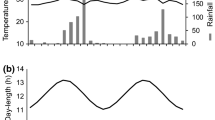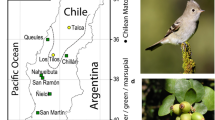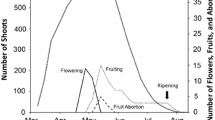Summary
A reduction in seed number per fruit is recognized as a common evolutionary trend among flowering plants. In order to evaluate the ecological role of single-seededness and its possible adaptive significance, we used van Roosmalen's (1985) descriptions of fruits for woody species in the Guianan flora to identify fruit and seed characters and dispersal syndromes associated with the single-seeded trait. We coded the following characters: seed number (one seed or more than one seed), fleshiness (dry or fleshy), dehiscence (dehiscent or indehiscent), dispersal syndrome, seed size (length), and fruit size (length). We ordered the data in a multi-dimensional contingency table and used maximum likelihood logistic regression to identify traits significantly correlated with single-seededness. Seed size and fruit size were treated as quantitative variables. Indehiscence and endozoochory are positively associated with single-seededness, with indehiscence contributing most to the best-fit model. Fruit size and seed size are also important with the probability of single-seededness generally increasing with seed size and decreasing with fruit size, although a (fruit size) x (seed size) interaction term is significant. Dry fruits are positively associated with single-seededness and dispersal by synzoochory or myrmecochory negatively associated when the full data set is examined, but neither parameter is significant in two models constructed to remove effects of phylogeny. A nested ANOVA revealed that most variation occurs below the family level for almost all of the traits considered, with the exception of the dry vs. fleshy trait for which there is no variation within genera. We argue that the strong association between indehiscence and single-seededness suggests selective advantages for single-seeded dispersal units but acknowledge that energetic trade-offs between seed number and seed size probably also occur. We suggest that the post-dispersal fates of seeds — especially those deposited in clumps by endozoochory — should be examined with the idea of identifying selective pressures on seed number per fruit.
Similar content being viewed by others

References
Adams MW (1967) Basis of yield component compensation in crop plants with special reference to the field bean, Phaseolus vulgaris Crop Sci 7:505–510
Augspurger CK (1986) Double- and single-seeded fruits of Platypodium elegans: consequences for wind dispersal and seedling growth and survival. Biotropica 18:45–50
Augspurger CK, Hogan KP (1983) Wind dispersal of fruits with variable seed number in a tropical tree (Lonchocarpus pentaphyllus: Leguminosae). Am J Bot 70:1031–1037
Bishop YMM, Feinburg SE, Holland PW (1975) Discrete multivariate analysis: theory and practice. Cambridge, MIT Press
Bradford DF, Smith CC (1977) Seed predation and seed number in Scheela palm fruits. Ecology 58:667–673
Casper BB (1984) On the evolution of embryo abortion in the herbaceous perennial Cryptantha flava. Evolution 38:1337–1349
Casper BB (1990) Seedling establishment from one- and two-seeded fruits of Cryptantha flava: a test of parent-offspring conflict. Am Nat 136:167–177
Casper BB, Grant BW (1988) Morphology and dispersal of one-and two-seeded diaspores of Cryptantha flava. Am J Bot 75:859–863
Casper BB, Wiens D (1981) Fixed rates of random ovule abortion in Cryptantha flava (Boraginaceae) and its possible relation to seed dispersal. Ecology 62:866–869
Cronquist A (1968) The evolution and classification of flowering plants. Houghton Mifflin, Co., Boston
Everitt BS (1977) The analysis of contingency tables. Chapman and Hall, London
Felsenstein J (1985) Phylogenies and the comparative method. Am Nat 125:1–15
Garrison WJ, Augspurger CK (1983) Double- and single-seeded acorns of bur oak (Ouercus macrocarpa): frequency and some ecological consequences. Bull Torrey Bot Club 110:154–160
Harvey PH, Pagel MD (1991) The comparative method in evolutionary biology. Oxford University Press, Oxford
Herrera CM (1984) Selective pressures on fruit seediness: differential predation of fly larvae on the fruits of Berberis hispanica. Oikos 42:166–170
Hodgson JG, Mackey JML (1986) The ecological specialization of dicotyledonous families within a local flora: some factors constraining optimization of seed size and their possible evolutionary significance. New Phytol 104:497–515
Howe HF (1986) Seed dispersal by fruit-eating birds and mammals. In: Murray DR (ed.) Seed dispersal, Academic Press, Sydney (pp. 123–190)
Howe HF (1989) Scatter- and clump-dispersal and seedling demography: hypothesis and implications. Oecologia 79:417–426
Huey RB, Bennett AF (1987) Phylogenetic studies of coadaptation: preferred temperatures vs. optimal performance temperatures of lizards. Evolution 41:1098–1115
Levey DJ, Grajal A (1991) Evolutionary implications of fruit-processing limitations in cedar waxwings. Am Nat 138:171–189
Loiselle BA (1990) Seeds in droppings of tropical fruit-eating birds: importance of considering seed composition. Oecologia 82:494–500
Maddison WP (1990) A method for testing the correlated evolution of two binary characters: are gains or losses concentrated on certain branches of an evolutionary tree? Evolution 44:539–557
Marshall DL, Levin DA, Fowler NL (1985) Plasticity in yield components in natural populations of three species of Sesbania. Ecology 66:753–761
Mazer SJ (1990) Seed mass of Indiana Dune genera and families: taxonomic and ecological correlates. Evol Ecol 4:326–357
Muenchow GE (1987) Is dioecy associated with fleshy fruit? Am J Bot 74:287–293
SAS Institute, Inc. (1985) SAS User's Guide: Statistics. Cary, North Carolina: SAS Institute, Inc
Snow DW (1971) Evolutionary aspects of fruit-eating by birds. Ibis 113:194–202
Stebbins GL (1967) Adaptive radiation and trends of evolution in higher plants. Evol Biol 1:101–142
Uma Shaanker RU, Ganeshaiah KN, Bawa KS (1988) Parentoffspring conflict, sibling rivalry, and brood-size patterns in plants. Ann Rev Ecol Syst 19:177–205
van Roosmalen MGM (1985) Fruits of the Guianan flora. Institute of Systematic Botany, Utrecht University
Author information
Authors and Affiliations
Rights and permissions
About this article
Cite this article
Casper, B.B., Heard, S.B. & Apanius, V. Ecological correlates of single-seededness in a woody tropical flora. Oecologia 90, 212–217 (1992). https://doi.org/10.1007/BF00317178
Received:
Accepted:
Issue Date:
DOI: https://doi.org/10.1007/BF00317178



